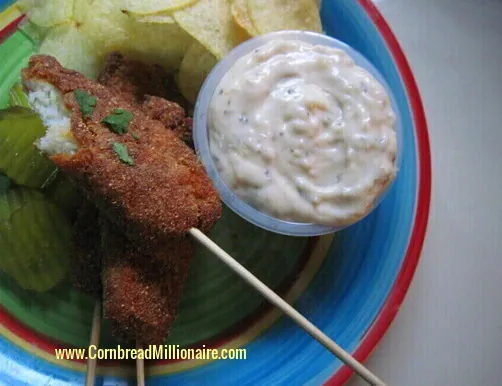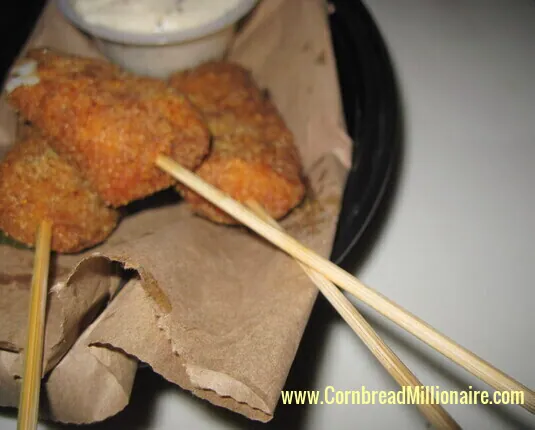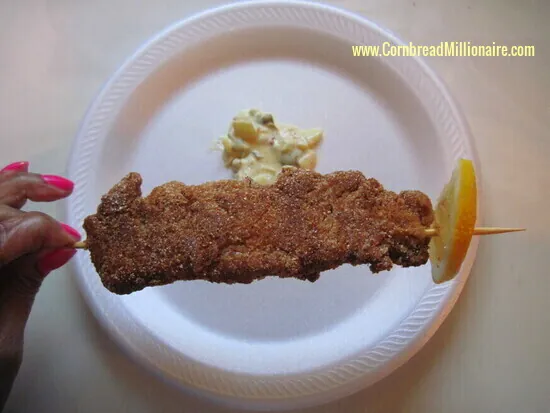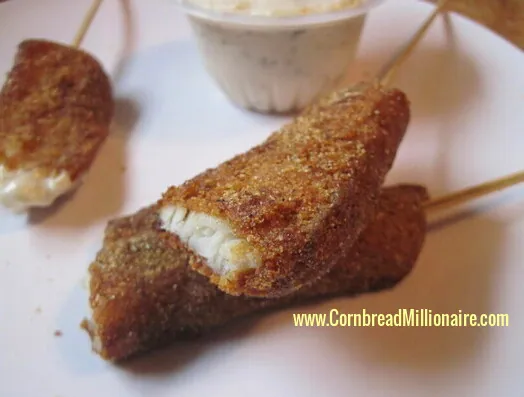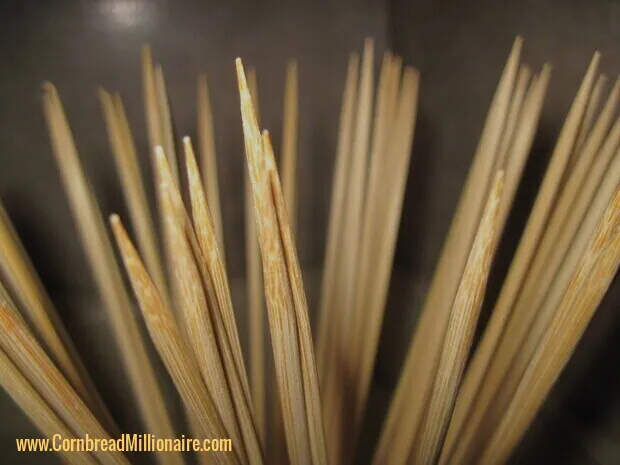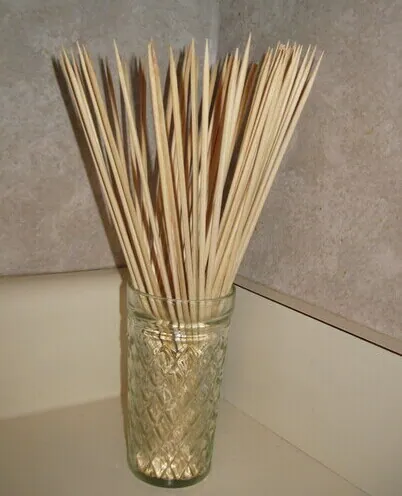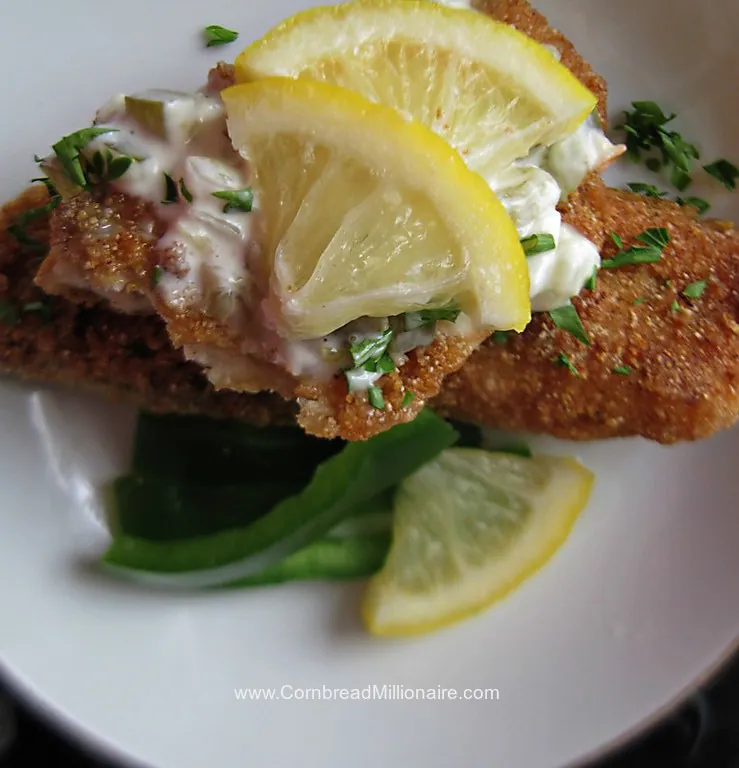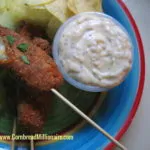Southern Fried Fish Sticks are easy to make and delicious. In this recipe, the fish strips are dipped in batter and fried until golden brown.
Then, a wooden bamboo stick is inserted inside each strip. Less hassle and a breeze to assemble.
Pairs well with my Homemade Tartar Sauce.
Makes a nice presentation. Perfect for any occasion.
Also delicious without the sticks.
What are the best fish for frying?
Alaskan cod, tilapia and catfish are excellent for frying.
Alaskan cod is often used in restaurants serving for fish and chips because it takes perfectly to the breading and high frying temps.
Don’t like cod? Try farm-raised tilapia or catfish. Both are affordable and readily available in most grocery stores.
Tilapia is a mild-tasting versatile fish that’s good with a variety of seasonings and batters. Catfish has a stronger taste. Superb with a corn meal breading.
A quick soak in a bowl of buttermilk and that fishy smell is dramatically reduced (almost gone). The fried fish is moist and has a delicious golden brown color.
Boiling white distilled vinegar and water in a boiler while fish is frying in skillet, will help eliminate fishy odors.
Remember to wipe stove and vent thoroughly with a soapy dishcloth after frying fish. Dry with a towel. Finally, open window and spray air freshener.
DISCLAIMER: This recipe is NOT sponsored. Pictured items are my personal favorites.
In my humble opinion, the best way to deep fry fish is in a cast iron skillet or dutch oven filled with hot shortening or a mixture of vegetable oil and shortening. Fish fries fast. After draining on paper towels, the crust is crispy and not greasy.
I purchased a package of 100 skewers in Walmart.
I asked a nice employee who was loading a shelf with merchandise, to help me find wooden skewers.
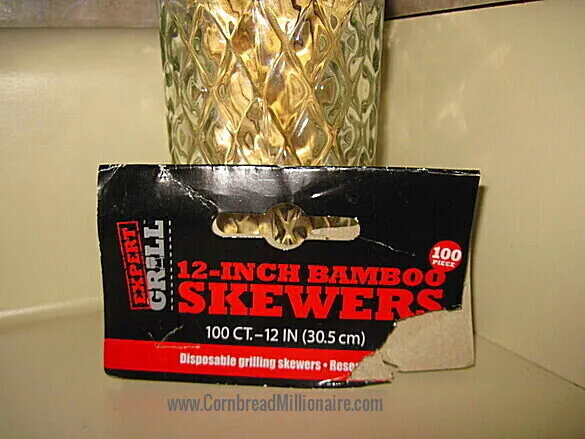
He “pointed” me to a shelf near the barbecue grills, grill appliances and charcoal. Voila! Walked right to them.
This mention is not sponsored. Just sharing helpful information.
Did you know that 75% of the world’s supply of farm-raised catfish comes from Mississippi?
Humphreys-Belzoni, Mississippi claims the title of Catfish Capital of the World. The city always hosts a large World Catfish Festival in April.
Delicious with Homemade Tartar Sauce.
How To Read & Follow A Recipe
Reading a recipe is an important life skill. It starts with knowing how to read a recipe’s ingredients, follow the instructions, prep ingredients, and knowing what equipment to use.
The following tips and strategies will help beginners or experienced cooks create a delicious dish as intended in the recipe.
Start with clean hands and organized kitchen. Wash hands thoroughly. Make sure kitchen and countertops are clean before making a recipe.
Create a relaxing environment. Play favorite music while in the kitchen. I love listening to classical or gospel music.
Read the recipe. Don’t just quickly skim it. Thoroughly read from start to finish. Visualize doing each step which will help you avoid missing a step.
If you see ingredient that you and your family don’t use for whatever reason, use a substitutions or omit the ingredient.
My recipes are packed with helpful tips like shortcuts and serving sizes which save time time and help with meal planning.
Pay attention to the order in which ingredients are prepped. For example, 1 cup of chopped pecans is not the same as pecans, chopped (measure whole pecans and then chop).
Know the assumptions. For example, when my recipe calls for “sugar,” use granulated sugar. If brown sugar is an ingredient, it will be written as such in the recipe.
Figure out the timing. Check the listed “prep time” and “total time” to be sure you have enough time to complete the recipe.
Look for hints, such as the words “meanwhile” or “at the same time,” which indicate two or more steps can happen simultaneously.
For example, my prep time doesn’t include bringing cold butter up to room temperature. Be sure to include in your timetable.
Watch Recipe Videos. If you’re a visual learner (like me), watch recipe videos. Perfect for when you’re learning a new skill or just want to see how a recipe is made.
Mise en place is a super time saver. This French cooking term translates as “putting in place.” It means prepping/measuring ingredients and chopping food before you start cooking. It’s the perfect way to get organized and avoid missing an ingredient or missing a step in the instructions.
Organize your tools and kitchen equipment. Mise en place isn’t just for ingredients. Before starting, make sure you have parchment paper, aluminum foil, measuring cups, measuring spoons, the right pans, mixing bowls, and other equipment.
Make notes in your recipe. Note any special prep instructions and highlight cooking times. Make note of ingredients omitted, favorite substitutions and creative twists. The notes will be very helpful the next time you make this recipe.
Enjoy!
Southern Fried Fish Sticks
Ingredients
- 6 firm white fish fillets Cut into strips (preferred size).
- 1 cup buttermilk For soaking fish.
- 1-1/2 cups yellow cornmeal mix Or use white cornmeal mix.
- salt to taste
- black pepper to taste
- 1/2 teaspoon old bay seasoning optional
- 1-1/2 cups shortening For frying fish.
- 6 wooden bamboo skewer sticks Plus a few extras in case of breakage.
- 6 lemon wedges For garnish.
Instructions
- Place strips in a pie plate or shallow dish. Cover with buttermilk (add more if needed to cover). Soak for 10 minutes. Drain. Do not rinse. Set aside.
- Place cornmeal mix, salt, black pepper, paprika, and Old Bay Seasoning in a clear zippered bag OR in a shallow baking dish. Shake until evenly combined. Set aside.
- Place shortening in 10 inch cast iron skillet or dutch oven.
- Warm over low-medium heat until sizzling hot.
- While shortening is warming, place all fish strips in zippered bag. Shake until evenly coated. Remove 3 strips and place in HOT skillet with hot shortening. Fry 3-4 minutes on each side or until fish is solid white inside, golden brown outside.
- Remove and drain on paper towels.
- Place last 3 strips in hot oil. Repeat as instructed above.
- Carefully insert sticks into THICK end of warm fried fish. Push through until end comes out of other side. Place a lemon wedge on end.
- Serve immediately with tartar sauce or preferred condiments.

